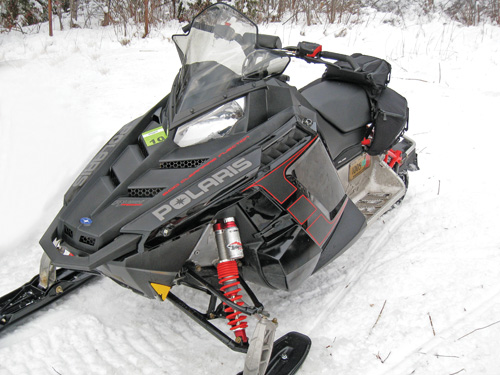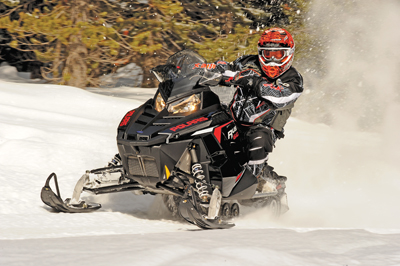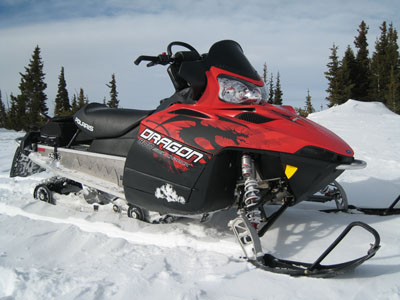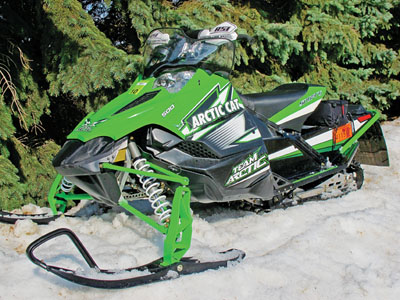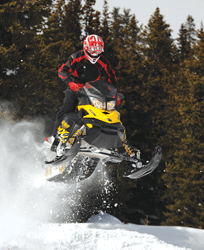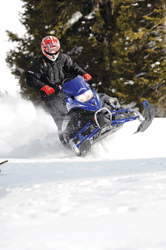 Never mind your beer gut, post-holiday largesse or other winter insulation you may be carrying around — we expect more from our sleds: top-grade engineering with a focus on minimal poundage, leading-edge materials and a quick and agile ride on the trails. Pounds matter when it comes to handling and, if you’re a racer, sometimes it comes down to ounces.
Never mind your beer gut, post-holiday largesse or other winter insulation you may be carrying around — we expect more from our sleds: top-grade engineering with a focus on minimal poundage, leading-edge materials and a quick and agile ride on the trails. Pounds matter when it comes to handling and, if you’re a racer, sometimes it comes down to ounces.
Thanks to advanced technology, the snowmobile industry has been counting carbs and slimmed down admirably over the last few decades. Like Americans, sleds are larger than they used to be, but extensive use of aluminum, plastics and other weight-shedding technologies have made them lighter for their size.
For some perspective, a 1985 Yamaha Phazer, diminutive by today’s standards, weighed in at a solid 487 pounds. A 1995 Polaris Indy RXL tipped the scales at a chunkier 544 pounds.
Today, most buyers peruse sled weights when shopping around, and each brand has different ways of calculating mass: whether it’s filled with fluids (wet/curb) or dry — and there’s always a bit of fudge room, for whatever reason. Every season we keep them honest by traveling to area dealerships, hooking up our NASCAR-style Intercomp scales and weighing sleds for sale in dealerships. This year we visited six Minnesota dealerships: Waconia Power Sports in Waconia, Danner Sales in Inver Grove Heights, Waldoch Sports in Forest Lake, Moon Motorsports in Monticello, St. Boni Motorsports in St. Bonifacius and Tri-K Sports in Maple Plain.

We asked that all machines had empty gas tanks, and siphoned out or mathematically compensated for weight in the ones that were already filled. FYI: each gallon of gas weighs 6.133 pounds. With so many factors going into the weight of a specific sled, these listings are meant to provide basic apples-to-apples information and to verify the manufacturers’ own weight numbers. Other than that, the sleds were weighed “ready to ride,” meaning they have oil in the chaincase, antifreeze in the cooling system, some starter oil in the tank of two-strokes, and a full crankcase in four-strokes.
Enjoy the fruits of our research, but remember that rider positioning and our body weighs can have a drastic effect on real-world weight distribution and total mass on the trail. Also note that weight is just one buying factor – power, handling, comfort, ergonomics and other issues are also worthy of concern. Because Arctic Cat and Yamaha do not publish claimed sled weights, we aren’t doing a comparison to each factory’s spec charts this year – we’re just showing you exactly what the sleds weighed.
The Facts:
Heaviest sled weight:
Arctic Cat TZ1 Turbo Touring 718
Lightest sled weight:
Ski-Doo MX Z TNT?550F – 417
Random weight #1:
Used Yamaha SnoScoot – 233
Random weight #2:
Toro Power Max 1028 OXE – 245
Combined weight of all
24 snowmobiles: – 12,921
Weight of a full-grown
13-ft tall male elephant: – 13,000

